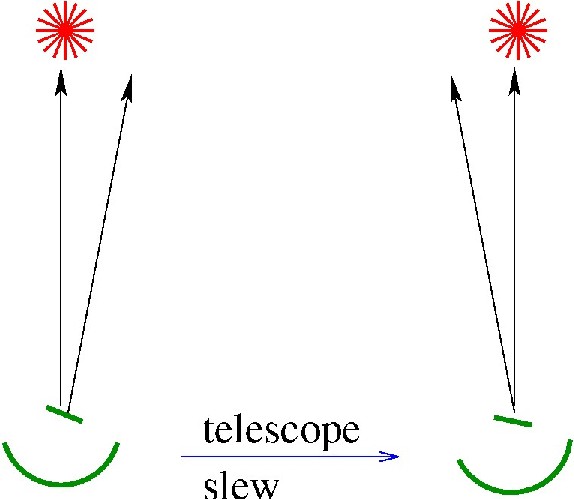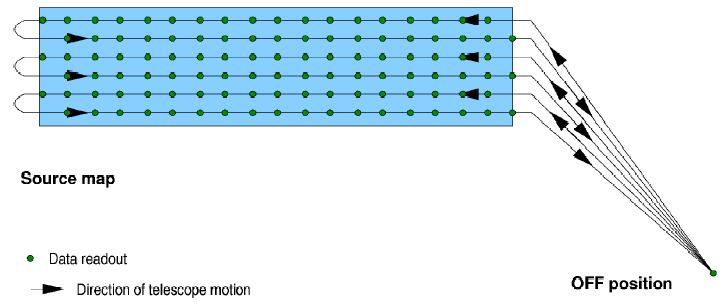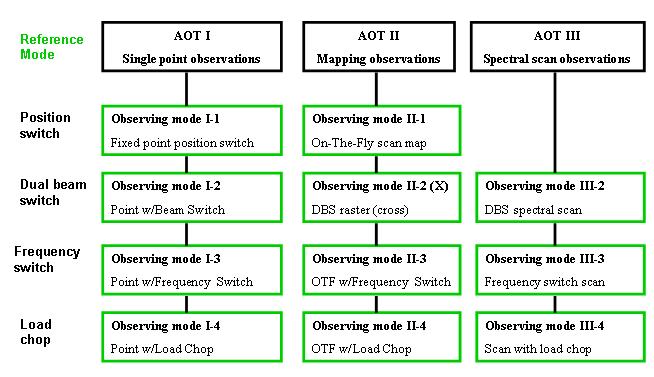HIFI provides 3 different Astronomical Observing Templates (AOTs): Single Point, Mapping and Spectral Scanning.
|
The HIFI's user can create an astronomical observation by choosing in a waste range of different observing modes. Each possible mode
is contained in one of the three classes of the instrument AOTs:
Only one Local Oscillator band is available to yield a single astronomical observing request (Tab.1).
|
| Band |
Mixer Type |
LO Lower freq. |
LO Upper freq. |
Beam Size (HPBW) |
IF Bandwidth |
| 1 |
SIS |
488.1 GHz |
628.4 GHz |
39" |
4.0 GHz |
| 2 |
SIS |
642.1 GHz |
793.9 GHz |
30" |
4.0 GHz |
| 3 |
SIS |
807.1 GHz |
952.9 GHz |
25" |
4.0 GHz |
| 4 |
SIS |
957.2 GHz |
1113.8 GHz |
21" |
4.0 GHz |
| 5 |
SIS |
1116.2 GHz |
1271.8 GHz |
19" |
4.0 GHz |
| 6+7 |
HEB |
1430.2 GHz |
1901.8 GHz |
13" |
2.4 GHz |
|

Fig.1: Dual Beam Switch mode
Click on to see the full size image
The Single Point Mode allows a single point source observation within a single Intermediate Frequency (IF) band. There are four modes to observe in AOT-1: Position Switch;
Dual Beam Switch; Frequency Switch and Load Chop.
Each mode permits to achieve the science goal by observing a target with the best conditions in terms of measurements, operations and calibrations.
Following we briefly summarize the different modes.
- The Position Switch mode is the simplest way to observe a source with HIFI. The aquisitions are made by pointing alternatively the source and the sky reference
within 2 degrees from the target. In the pipeline processing the sky is subtracted from the scientific target source.
- In the Dual Beam Switch (DBS) mode the internal mirror moves between the target position and a fixed sky region located at 3 arcminutes from the scientific source.
The mirror chopping has two possible speeds, a slow chop with a frequency of 0.125Hz and a fast chop up to 4Hz.
Together to the internal chopping, the telescope nodding permits to avoid residual ripples (Fig.1).
- If no sky reference is located near the target within 2 degrees, the Frequency Switch mode is used. This method uses a switching between two close
frequencies of the Local Oscillator and the difference between the two acquisition is used to remove the baseline. Using this method
for the baseline subtraction, also the continuum emission will be removed. Further ripples can be removed by measuring
the sky in a free emission/absorption region with the two frequencies.
This mode is suggested only for target with simple spectra (the difference between two acquisitions could introduce spurious features within complex spectra) and it is not recommended in
the frequency range 1430-1901GHz, due to baseline instability.
- The Load Chop mode is used when no sky reference is avaible near the target or when target spectrum presents several complexity.
In this case an internal cold radiation is generated as reference, and the chopping mirror moves from the target on sky to the internal source.
The occurrence of residual standing wave can be reduced by acquiring sky measurements (always recommended).
|

Fig.2: Mapping mode
Click on to see the full size image
The Mapping method is used to observe extended sources. Four modes are avaible for this AOT: On-The-Fly (OTF) with Position Switch Reference (PSR);
Raster Map (RM) with Dual Beam Switch (DBS); OTF Maps with Frequency Switch and OTF Maps with Load Chop.
- The OTF with PSR is used to observe an extended source and a sky reference within 2 degrees from the target.
This mode is the most used for mapping a region and it is affected by trascurable standing wave problems. The scanning is made line by line
changing the direction of acquisition (Fig.2).
- The RM with DBS mode uses a sky reference fixed at 3 arcmin from the either side of each grid position. The sky limited position,
prevent the observations of large extended regions.
- By selecting the OTF mode with Frequency Switch the target observations are made by switching in frequency.
It works similarly to the single point Frequency Switch mode and it can be used to observe large regions since the sky acquisitions are not necessary.
- In the OTF with Load Chop internal sources are used as reference (see Load Chop mode for single point). This mode is suggested for extended regions since the
sky reference is not required.
|
The third AOT consists of Spectral Scanning (SS) modes based on the observations of a single target with different frequencies over a large range (>20GHz).
As main backend the WBS spectrometer is used. There are three avaible modes of observation: DBS; Frequency Switch and Load Chop.
- Similarly to the single point and map modes, in the DBS SS the sky is fixed at 3 arcminutes.
In each observations the Local Oscillator is calibrated individually by using internal sources.
- As for the the single point and map modes, in the Frequency Switch SS a switching in frequency is used as reference. A sky reference position is avaible to calibrate the baseline.
- Similarly to the others Load Chop modes, in the SS is possible to use internal loads as reference. The internal measurements can be made for every Local
Oscillator frequency used by the scan.
All modes are shown briefly in Fig.3.
|

Fig.3: HIFI AOT observing modes
Click on to see the full size image
|

